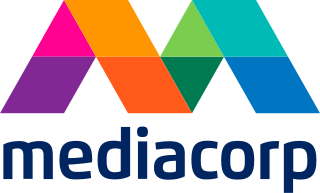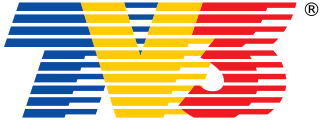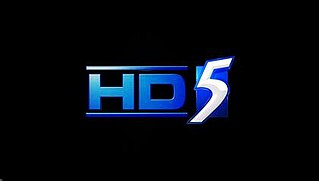Related Research Articles

Mediacorp Pte. Ltd. is the state-owned media conglomerate of Singapore. Owned by Temasek Holdings—the investment arm of the Government of Singapore—it owns and operates television channels, radio, and digital media properties. It is headquartered at the Mediapolis development in Queenstown's One-north precinct, which succeeded Caldecott Hill—the long-time home of its predecessors—in 2015; as of 2022, Mediacorp employs over 3,000 employees; a large number of them are in both public and private sector broadcasting.
Television in Singapore began on 15 February 1963. The public broadcaster, MediaCorp TV, has a monopoly on terrestrial television channels and is fully owned by government holding company Temasek Holdings. Local pay TV operators are StarHub TV and Singtel TV. The private ownership of satellite dishes was previously forbidden.

Channel 5 is an English-language free-to-air terrestrial television channel in Singapore, owned by state media conglomerate Mediacorp. The channel primarily airs English language programming made in Singapore, and imported programmes from other nations such as the United States, United Kingdom, Australia and Philippines, broadcasting news and entertainment from a variety of genres.

Channel 8 is a Singaporean Mandarin-language free-to-air terrestrial television channel in Singapore, owned by state media conglomerate Mediacorp. The channel broadcasts general entertainment and news programming in the Mandarin language, including original and imported programming.

Channel U is a Mandarin-language free-to-air terrestrial television channel in Singapore, owned by state media conglomerate Mediacorp.

Sistem Televisyen Malaysia Berhad, operating as TV3, is a Malaysian free-to-air television channel owned by Malaysian media conglomerate, Media Prima. TV3 is the third oldest TV station in Malaysia. It was launched on 1 June 1984 as the country's first and oldest private television channel. As of October 2021, TV3 remains to be the most-watched television station in Malaysia with about 17% of its viewing share among other Malaysian television stations, followed by TV9 with 15% of its viewing share, making two of them become the second most-watched television station in the country, despite the declining viewership of 3 free-to-air television channels.

CNA is a Singapore-based multinational news channel owned by Mediacorp, the country's state-owned media conglomerate. The network is broadcast in Singapore on free-to-air terrestrial television and Mediacorp's streaming service meWatch, and is distributed internationally via television providers in the Asia–Pacific, as well as streaming and free ad-supported streaming television (FAST) platforms
The following lists events that happened during 2004 in Singapore.
The following lists events that happened during 2001 in Singapore.

Star Hub TV is a pay television service provided by StarHub in Singapore. It has been a subsidiary of StarHub Limited since StarHub acquired Singapore Cable Vision (SCV) in 2001, and was the sole pay-TV operator in the country until 2007 when mio TV, an IPTV service from its competitor, Singtel, was launched.
Today was a Singaporean digital news magazine published by Mediacorp. It was originally established on 10 November 2000 as a free print newspaper, competing primarily with Singapore Press Holdings' (SPH) Streats.
On 31 December 2004, Singapore's national broadcaster MediaCorp and SPH MediaWorks, the broadcasting arm of Singapore Press Holdings, agreed to merge their operations, with the merger taking effect on 1 January 2005. This merger arrangement remained in effect until 29 September 2017, when SPH exited the partnership by divesting its stake in MediaCorp.
Central was a Singaporean free-to-air terrestrial television channel in Singapore, owned by state media conglomerate MediaCorp.
Suria is a Malay-language free-to-air terrestrial television channel in Singapore, owned by state media conglomerate Mediacorp. The channel broadcasts general entertainment and news programming in the Malay language, including original programming, and imported programmes from Malaysia and Indonesia.

HD5 was a Singaporean free-to-air television channel that was launched as the high-definition version of Channel 5. The channel was the first HD broadcast on DTT in Southeast Asia. HD5 aired 10 hours of HD-produced series each week, including movies, dramas, and original productions made by Mediacorp.
Vasantham is a Tamil-language free-to-air terrestrial television channel in Singapore, owned by state media conglomerate Mediacorp. The channel broadcasts entertainment and news programming targeting the Singaporean Indian community.

SPH MediaWorks Ltd. was a free-to-air terrestrial television broadcaster in Singapore that operated two television channels: Channel U and Channel i, as well as two radio stations: UFM 1003 and WKRZ 91.3FM. It merged with the city-state's long-established broadcasting company, Mediacorp, in 2004.

Okto is a Singaporean children's programming block broadcast by Mediacorp's Channel 5 in English and Channel 8 in Mandarin Chinese.
Evelyn Tan Yuit Yin is a Singaporean actress, host, educator and former singer.

Channel i was a Singaporean English language free-to-air terrestrial television channel owned by SPH MediaWorks, a broadcasting subsidiary of Singapore Press Holdings.
References
- ↑ "TCS sees market for second all-Chinese TV channel". The Straits Times (retrieved from NLB). 30 September 1995. Retrieved 23 May 2024.
- ↑ "New sports channel coming your way". The Straits Times (retrieved from NLB). 7 July 1999. Retrieved 29 August 2024.
- ↑ "Even the most sporty will be glued to couch". The Straits Times (retrieved from NLB). 29 October 1999. Retrieved 23 May 2024.
- ↑ "BATTLE STATIONS". The Straits Times (retrieved from NLB). 4 January 2000. Retrieved 23 May 2024.
- ↑ "Local channels bid for Tyson's big fight". The Straits Times (retrieved from NLB). 15 January 2000. Retrieved 23 May 2024.
- ↑ "Page 45 Miscellaneous Column 1". The Straits Times (retrieved from NLB). 30 January 2000. Retrieved 23 May 2024.
- ↑ "You'll be Bowl-ed over". The Straits Times (retrieved from NLB). 30 January 2000. Retrieved 23 May 2024.
- ↑ "MORE EVENTS TO BE SHOWN LIVE". The Straits Times (retrieved from NLB). 13 January 2000. Retrieved 23 May 2024.
- 1 2 "They'll give you the buzz in sports". The Straits Times (retrieved from NLB). 15 January 2000. Retrieved 23 May 2024.
- ↑ "It'll have a local flavour". The Straits Times (retrieved from NLB). 15 January 2000. Retrieved 23 May 2024.
- ↑ "About SPORTSCITY". Sportscity. 2000. Archived from the original on 18 October 2000. Retrieved 27 May 2024.
- ↑ "Fuzz over tuning in to Sports City". The Straits Times (retrieved from NLB). 1 February 2000. Retrieved 23 May 2024.
- ↑ "Media Works gets Red Devils' ties". The Straits Times (retrieved from NLB). 18 January 2001. Retrieved 13 September 2023.
- ↑ "Catch EPL action on TV Works". Streats (retrieved from NLB). 17 August 2001. Retrieved 13 September 2023.
- 1 2 "A channel for trendy adults". Today (retrieved from NLB). 4 May 2001. Retrieved 23 May 2024.
- ↑ ": : : ABOUT CITY TV : : :". City TV. January 2000. Archived from the original on 19 June 2001. Retrieved 28 May 2024.
- 1 2 "Action station". Today (retrieved from NLB). 11 May 2001. Retrieved 28 May 2024.
- ↑ "TV for the hip & trendy". Today (retrieved from NLB). 10 May 2001. Retrieved 28 May 2024.
- 1 2 3 "Seventh Annual Report by the Programme Advisory Committee (PAC)" (PDF). Infocomm Development Authority. Retrieved 2024-05-04.
- ↑ "Why slash sports programming, MediaCorp?". The New Paper (retrieved from NLB). 18 May 2001. Retrieved 28 May 2024.
- ↑ "Sports cutback is minimal, says MediaCorp". The New Paper (retrieved from NLB). 19 May 2001. Retrieved 28 May 2024.
- ↑ "Wrestling shows not for kids: SBA". Streats (retrieved from NLB). 18 May 2001. Retrieved 28 May 2024.
- ↑ "Sports cutback is minimal, says MediaCorp". The New Paper (retrieved from NLB). 19 May 2001. Retrieved 28 May 2024.
- ↑ "MediaCorp TV to shut down City TV channel". The Straits Times (retrieved from NLB). 10 January 2002. Retrieved 23 May 2024.
- ↑ "A sports fan's plea". Today (retrieved from NLB). 16 January 2002. Retrieved 23 May 2024.
- ↑ "Tuning In". Sportscity. January 2000. Archived from the original on 11 April 2000. Retrieved 27 May 2024.
- ↑ "SCV; SCV MaxTV; Price Plan". SCV MaxTV. May 2001. Archived from the original on 8 May 2001. Retrieved 27 May 2024.